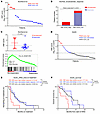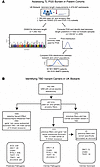Issue published August 15, 2025 Previous issue

- Volume 135, Issue 16
Go to section:
On the cover: SOX2 regulates upper GI squamous epithelial identity
Jin et al. report the critical role of the transcription factor SOX2 in foregut squamous epithelial differentiation. Decreased expression of SOX2 is an initiating step in progression to Barrett’s esophagus. The cover art was produced using Adobe Photoshop based on an H&E image of Barrett’s esophagus adjacent to esophageal squamous epithelium. Image credit: Ramon Jin.
In-Press Preview - More
Abstract
Calciphylaxis is a rare but life-threatening disorder characterized by ectopic calcification affecting the subcutaneous tissues and blood vessels of the skin. Once diagnosed, survival rates are less than a year and yet despite the severity of the condition, the pathobiology of calciphylaxis is ill understood. Here, we create animal models of calciphylaxis that recapitulate many characteristics of the human phenotype. We demonstrate that cutaneous calcification is preceded by inflammatory cell infiltration. We show that increased local skin inflammation, regardless of the inciting cause, in the presence of hypercalcemia and hyperphosphatemia contributes to cutaneous ectopic calcification. Genetically modified rodents lacking immune activation of T and B cells or NK cells are resistant to developing cutaneous calcification. Consistent with this, administration of the immunosuppressive cyclophosphamide rescued calcific deposits as did T cell suppression with cyclosporine. We demonstrate IL17 is upregulated in calcific skin and neutrophils are the predominant cell types expressing IL 17 and tissue alkaline phosphatase that is necessary for ectopic calcification. Targeting IL17 with a monoclonal antibody or using a myeloperoxidase inhibitor to blunt neutrophil activation notably attenuated calcific deposits in vivo. Taken together, these observations provide fresh insight into the role of the immune system and the IL17/neutrophil axis in mediating ectopic calcification in rodent models of calciphylaxis.
Authors
Bo Tao, Edward Z. Cao, James Hyun, Sivakumar Ramadoss, Juan F. Alvarez, Lianjiu Su, Qihao Sun, Zhihao Liu, Linlin Zhang, Alejandro Espinoza, Yiqian Gu, Feiyang Ma, Shen Li, Matteo Pellegrini, Arjun Deb
Abstract
Genome editing has shown the potential to treat genetic hearing loss. However, current editing therapies for genetic hearing loss have shown efficacy only in hearing rescue. In this study, we evaluated a rescue strategy using AAV2-mediated delivery of SaCas9/sgRNA in the mature inner ear of the P2rx2V61L/+ mouse model of DFNA41, a dominant, delayed-onset, and progressive hearing loss in humans. We demonstrate that local injection in adult mice results in efficient and specific editing that abolishes the mutation without notable off-target effects or AAV genome integration. Editing effectively restores long-term auditory and vestibular function. Editing further protects P2rx2V61L/+ mice from hypersensitivity to noise-induced hearing loss (NIHL), a phenotype also observed in DFNA41 patients. Intervention at a juvenile stage broadens the frequency range rescued, highlighting the importance of early intervention. An effective and specific gRNA for the human P2RX2 V60L mutation has been identified. Our study establishes the feasibility of editing to treat DFNA41 caused by P2RX2 V60L mutation in humans and opens an avenue for using editing to rescue hearing and vestibular function while mitigating noise-induced hearing loss.
Authors
Wei Wei, Wenliang Zhu, Stewart Silver, Ariel M. Armstrong, Fletcher S. Robbins, Arun Prabhu Rameshbabu, Katherina Walz, Yizhou Quan, Wan Du, Yehree Kim, Artur A. Indzhykulian, Yilai Shu, Xue-Zhong Liu, Zheng-Yi Chen
Abstract
Cyclin-dependent kinase 4/6 inhibitors (CDK4/6i) have transformed the treatment landscape for hormone receptor-positive (HR+) breast cancer. However, their long-term efficacy is limited by acquired resistance, and CDK4/6i monotherapy remains ineffective in triple-negative breast cancer (TNBC). Here, we demonstrate that dual inhibition of CDK4/6 and CDK7 is a promising strategy to overcome therapeutic resistance in both HR+ and TNBC models. Kinetic analyses reveal that CDK7 inhibitors (CDK7i) primarily impair RNA polymerase II-mediated transcription rather than directly targeting cell-cycle CDKs. This transcriptional suppression attenuates E2F-driven transcriptional amplification, a key mechanism for developing CDK4/6i resistance following the degradation of the retinoblastoma protein. Consequently, combining CDK7i at minimal effective concentrations with CDK4/6i potently inhibits the growth of drug-resistant tumors. Furthermore, dual CDK4/6 and CDK7 inhibition stimulates immune-related signaling and cytokine production in cancer cells, promoting anti-tumor immune responses within the tumor microenvironment. These findings provide mechanistic insights into CDK inhibition and support the therapeutic potential of combining CDK7i with CDK4/6i for breast cancer treatment.
Authors
Sungsoo Kim, Eugene Son, Ha-Ram Park, Minah Kim, Hee Won Yang
Abstract
Toll like receptor (TLR) 7 and 9, endosomal sensors for RNA and DNA, are key mediators of autoreactivity. Although generally considered homologous, they paradoxically have opposing effects on lupus: TLR7 exacerbates disease while TLR9 protects from disease. How they mediate opposing effects in autoimmunity remains undetermined. We hypothesized that differences in signaling qualities of the Toll-Interleukin 1 Receptor (TIR) domains of TLR7 and TLR9 could be responsible for their opposing effects. To test this, we introduced the TIR domain of TLR9 into the endogenous TLR7 locus and the TLR7 TIR domain into the endogenous TLR9 locus of mice, creating chimeric molecules termed TLR779 and TLR997. Lupus-prone MRL/lpr mice carrying Tlr779 had greatly ameliorated disease while MRL/lpr mice carrying Tlr997 had markedly exacerbated disease compared to respective TlrWT mice. These experiments establish that TLR7 and TLR9 TIR domains have divergent properties and control disease quality, thus explaining the longstanding “TLR paradox.”
Authors
Claire Leibler, Kayla B. Thomas, Coralie Josensi, Russell C. Levack, Shuchi Smita, Shinu John, Daniel J. Wikenheiser, Sheldon Bastacky, Sebastien Gingras, Kevin M. Nickerson, Mark J. Shlomchik
Abstract
Despite the potential of targeted epigenetic therapies, most cancers do not respond to current epigenetic drugs. The Polycomb repressive complex EZH2 inhibitor tazemetostat was recently approved for the treatment of SMARCB1-deficient epithelioid sarcomas, based on the functional antagonism between PRC2 and SMARCB1. Through the analysis of tazemetostat-treated patient tumors, we recently defined key principles of their response and resistance to EZH2 epigenetic therapy. Here, using transcriptomic inference from SMARCB1-deficient tumor cells, we nominated the DNA damage repair kinase ATR as a target for rational EZH2 combination epigenetic therapy. We showed that EZH2 inhibition promotes DNA damage in epithelioid and rhabdoid tumor cells, at least in part via its induction of piggyBac transposable element derived 5 (PGBD5). We leveraged this collateral synthetic lethal dependency to target PGBD5-dependent DNA damage by inhibition of ATR, but not CHK1, using the ATR inhibitor elimusertib. Consequently, combined EZH2 and ATR inhibition improved therapeutic responses in diverse patient-derived epithelioid and rhabdoid tumors in vivo. This advances a combination epigenetic therapy based on EZH2-PGBD5 synthetic lethal dependency suitable for immediate translation to clinical trials for patients.
Authors
Yaniv Kazansky, Helen S. Mueller, Daniel Cameron, Phillip Demarest, Nadia Zaffaroni, Noemi Arrighetti, Valentina Zuco, Prabhjot S. Mundi, Yasumichi Kuwahara, Romel Somwar, Rui Qu, Andrea Califano, Elisa de Stanchina, Filemon S. Dela Cruz, Andrew L. Kung, Mrinal M. Gounder, Alex Kentsis
View more articles by topic:
Sign up for email alerts
Review Series - More
Series edited by Ben Z. Stanger
Pancreatic Cancer
Series edited by Ben Z. Stanger
Pancreatic ductal adenocarcinoma (PDAC) has among the poorest prognosis and highest refractory rates of all tumor types. The reviews in this series, by Dr. Ben Z. Stanger, bring together experts across multiple disciplines to explore what makes PDAC and other pancreatic cancers so distinctively challenging and provide an update on recent multipronged approaches aimed at improving early diagnosis and treatment.
×






























